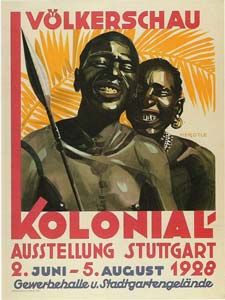 Advertising poster for a human zoo in Germany(1928). (Image credit: https://www.popularresistance.org/deep-racism-the-forgotten-history-of-human-zoos/)
Advertising poster for a human zoo in Germany(1928). (Image credit: https://www.popularresistance.org/deep-racism-the-forgotten-history-of-human-zoos/)
The Concept. Fusco and Gómez-Peña planned to live in a golden cage for three days, to be displayed as Amerindians from an undiscovered island in the Gulf of Mexico called Guatinau. The artists were exhibited performing “traditional tasks”, which included sewing voodoo dolls, watching television, lifting weights and working on a laptop. The spectators of the piece could also “donate” to the museum in order for the artists to perform a series of tasks.
Coco Fusco explains,
“A donation box in front of the cage indicated that, for a small fee [one dollar], I would dance (rap music), Guillermo would tell authentic Amerindian stories (in a nonsensical language), and we would pose for Polaroids with visitors. Two “zoo guards” would be on hand to speak to visitors (since we could not understand them), take us to the bathroom on leashes, and feed us sandwiches and fruit. At the Whitney Museum in New York we added sex to our spectacle, offering a peek at authentic Guatinaui male genitals for $5” (Fusco, 1995, 39).
One of the most surprising findings from this performance, which neither Coco Fusco nor Guillermo Gómez-Peña anticipated, was the number of people who believed the exhibit to be real. Over 50% of the spectators believed that the artists were natives of Guatinaui. This was not the intention of the piece “our original intent was not to convince people that the fiction of our being Amerindians was a reality. We understood it to be a satirical commentary both on the quincentenary celebrations and on the history of this practice of exhibiting human beings from Africa, Asia, and Latin America in Europe and the United States in zoos, theatres, and museums” (Fusco, 1993). So what was the legitimising factor? Why did so many believe the performance? It’s simple. People trust museums. With nothing more than a chronology, highlighting the history of exhibiting non-western people, and a fake Encyclopaedia Britannica entry and map of the Gulf of Mexico showing Guatinaui, the artists created “fact”.
This ability to legitimise the truth is a dangerous power, especially when coupled with the exhibition of the “other”, which museums have long held. It allows for these institutions to aid certain values and oppress others.
As Diana Taylor states “Since their inception in the 19th century, museums have literalized the theatricality of colonialism taking the cultural other out of context and isolating it, reducing the live performance of cultural practice into a dead object behind glass. Museums enact the knower/known relationship, preserve (a particular) history, (certain) traditions, and (dominant) values. The monumentality of most museums emphasizes the discrepancy in power between the society which can contain all others, and those represented only by remains, the shards and fragments salvaged in miniature displays” (Taylor, 1998, 161).
Therefore, museums which are often owned and managed by the elite of our society, can perpetuate hierarchies which allow for racial or gender superiority.
Works Cited:
Fusco, C. (1993) Artists in Conversation: Coco Fusco and Guillermo Gómez-Peña. [Interview] Bomb Magazine. Interviewed by Anna Johnson. [Online] Available from: http://bombmagazine.org/article/1599/ [Accessed 15 February 2015].
Fusco, C. (1995) English Is Broken Here: Notes on Cultural Fusion in the Americas. New York: The New Press.
Taylor, D. (1998) A Savage Performance: Guillermo Gomez-Pena and Coco Fusco’s “Couple in the Cage”. The Drama Review, 42(2) 160-175.
Recent Comments